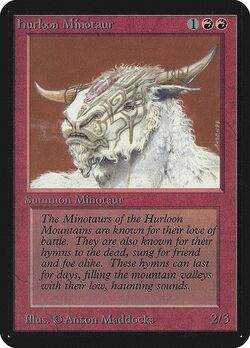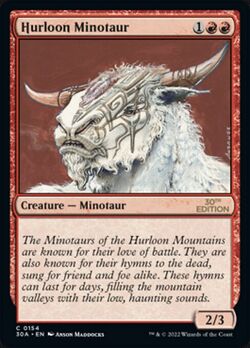Illustration


In the context of Magic, illustration refers to the picture on a card.[1][2][3] It is a piece of art created by an illustrator that visually represents a creature, a spell, a location or an object.
Description
Dimensions
The standard art box originally measured 2" x 1.5". The Magic 2015 card frame decreased the border size and allowed for a slightly bigger picture.[4] The illustration usually fills the top half of the card. Still, it may fill the full card on full-art and textless versions. Extended art, introduced for Ultimate Masters, extends the art on a card to the edge of the card on the left and right sides. Borderless, introduced in Unstable, extends through the full edge of the cards (including the top and sometimes also the bottom).
Art direction
The predominant look of the art has changed from set to set, but never more noticeably than when a new art director takes the reins. Since Magic 's initial release, art directors have included Jesper Myrfors (from Alpha through The Dark), Sandra Everingham (from Fallen Empires through Alliances), Sue Ann Harkey (Alliances through Weatherlight), Matt Wilson (Tempest up to Urza's Saga), and Jesper Myrfors again.[5][6] Nowadays, there are multple art directors; different sets have different art directors.[7] Magic art may be digital.[8] Creative has moved away from showing pieces of a sequential story on cards.[9] Instead, starting with Magic Origins, some cards show pivotal moments (Story Spotlights).[10]
Card art gets assigned in clumps. Each of these clumps is called an art wave.[11] Most sets have multiple art waves. Set Design works with the art director to determine which cards go in which art wave. Usually, the cards the lead set designer has the most confidence in, or which have a clear visual identity (such as legendary creatures we know are in the set), regardless of mechanics, go in the earlier waves. Each piece of art has a number assigned to it that's unique for that piece of art. Once the art is in and R&D changes cards in their database, they have to be aware of the art ID.[11]
Concepting
Each set has two "waves" of concept art. One of them happens at the beginning of development, and the other happens later on. When a card concept is thought up, it is further refined in an art description.[12] Cards have to be concepted early to give the flavor team and especially the artists enough lead time to work on them.[13][14][15][16][17][18][19]
The palette of the illustration — the artist's selection of colors — isn't required to match the colors of the card on which the art appears, i.e. a blue card doesn't have to have an illustration that is mainly blue.[20]
Modified art
The original art in Unholy Strength featured a flaming pentagram. As of Fourth Edition and subsequent reprinted versions, it was removed. It was the result of pressure from various groups against demonic and satanic themes.[21] Unholy Strength is by no means the only card in Magic where the art has been changed due to public outcry; other cards, including Crusade and Demonic Tutor, have been given alternate art for the same reason.
The People's Republic of China does not allow the public display of human or humanoid skeletons and Magic cards are no exception. For this reason the artwork of many Chinese-language cards depicting skeletons have to be modified to make it possible to sell the product.[22]
Artist pay and licensing
In 1999, Wizards of the Coast switched over from a primarily royalty-based payment system to an upfront payment system. Artists hated it, but there wasn’t getting around it. Magic had the opportunity to grow fast, and paying royalties was potentially a huge barrier to doing so. The amount they ended up paying at the time was a substantial decrease, but it might be argued that, for the time, it was a fair re-adjustment. According to artist Peter Mohrbacher, the real problem was that those rates were frozen in time between 1999 and 2014. Another perceived problem are the licensing deals that allow Wizards of the Coast money from merchandise while the artists receive nothing.[23]
Rules
From the glossary of the Comprehensive Rules (November 14, 2025—Avatar: The Last Airbender)
- Illustration
- A picture printed on the upper half of a card that has no effect on game play. See rule 203, “Illustration.”
From the Comprehensive Rules (November 14, 2025—Avatar: The Last Airbender)
- 203. Illustration
- 203.1. The illustration is printed on the upper half of a card and has no effect on game play. For example, a creature doesn’t have the flying ability unless stated in its rules text, even if it’s depicted as flying.
Related terms
Slush art
"Slush art" is art that was originally commissioned for a specific card but was ultimately unused and repurposed for a different card or project. The "slush art" file of Wizards of the Coast consists of several hundred pieces of Magic art.[24]
Key art
Since Rise of the Eldrazi, Magic sets often feature "key art".[25] This is a singular, iconographic image that is the foundation upon which a set's marketing campaign is built. Key art images appear on products like posters, booster boxes and fat packs/booster bundles but not on the cards themselves.[26] Key art is created for several reasons:
- Art for packaging/posters/advertising/etc. Has different needs than card art. Most importantly, it’ll be printed at a different size than card art, so it may want to have details that don’t read well at card size. But it may also be a different aspect ratio, where cropping it to the card frame would make it worse.
- It is commissioned on a later schedule than the card art. Even if it would work well on a card, it might’ve come in too late to be adapted for that purpose.
- It is unknown in advance which art briefs are going to produce illustrations that grab the audience.
Art as creature type
The silver-bordered Abstract Iguanart from Unsanctioned introduces the Art creature type.
See also
References
- ↑ Matt Cavotta (February 21, 2005). "The Big Deal About Little Pictures". magicthegathering.com. Wizards of the Coast. Archived from the original on 2021-04-18.
- ↑ Randy Buehler (November 21, 2003). "Flight of Fancy". magicthegathering.com. Wizards of the Coast. Archived from the original on 2021-04-29.
- ↑ Matt Cavotta (August 16, 2007). "Is it Live, or Is it Memorex?". magicthegathering.com. Wizards of the Coast. Archived from the original on 2021-04-22.
- ↑ Aaron Forsythe (January 06, 2014). "From the Director's Chair: 2013". magicthegathering.com. Wizards of the Coast.
- ↑ Pete Venters (June 01, 2009). "What You See Is What You Get". magicthegathering.com. Wizards of the Coast. Archived from the original on 2021-04-29.
- ↑ Matt Cavotta (December 14, 2005). "Art on the Fringes". magicthegathering.com. Wizards of the Coast. Archived from the original on 2021-04-29.
- ↑ Mark Rosewater. "#190 - A Card Being Made". Drive to Work. Transcript.
- ↑ Matt Cavotta (January 18, 2006). "RT3000, The Future of Magic Art". magicthegathering.com. Wizards of the Coast. Archived from the original on 2021-04-29.
- ↑ Doug Beyer (October 13, 2010). "The Key is Time". magicthegathering.com. Wizards of the Coast. Archived from the original on 2021-04-29.
- ↑ Sam Stoddard (August 21, 2015). "Developing for Story". magicthegathering.com. Wizards of the Coast. Archived from the original on 2021-04-29.
- ↑ a b Mark Rosewater (January 10, 2022). "Even More Words From R&D". magicthegathering.com. Wizards of the Coast.
- ↑ Doug Beyer (July 30, 2008). "Concepting Eventide, Part 2". magicthegathering.com. Wizards of the Coast. Archived from the original on 2020-11-12.
- ↑ Matt Cavotta (March 08, 2006). "Card Concept: "Who Is This Unsung Hero?"". magicthegathering.com. Wizards of the Coast. Archived from the original on 2021-04-29.
- ↑ Matt Cavotta (July 05, 2007). "How Art Thou?". magicthegathering.com. Wizards of the Coast. Archived from the original on 2019-04-15.
- ↑ Doug Beyer (April 01, 2009). "Magic Art Tropes". magicthegathering.com. Wizards of the Coast. Archived from the original on 2021-04-29.
- ↑ Gavin Verhey (January 04, 2013). "Greetings and Extortions!". magicthegathering.com. Wizards of the Coast. Archived from the original on 2021-04-29.
- ↑ Doug Beyer (June 17, 2009). "Flavor Driven". magicthegathering.com. Wizards of the Coast. Archived from the original on 2019-03-20.
- ↑ Doug Beyer (August 05, 2009). "Keeping Spells Spellish". magicthegathering.com. Wizards of the Coast. Archived from the original on 2021-04-29.
- ↑ Doug Beyer (May 05, 2010). "Form of the Writer". magicthegathering.com. Wizards of the Coast. Archived from the original on 2021-02-25.
- ↑ Doug Beyer (June 23, 2010). "Palette vs. Color". magicthegathering.com. Wizards of the Coast. Archived from the original on 2021-04-29.
- ↑ Mark Rosewater (5 July 2004). "Where Have All The Demons Gone?". magicthegathering.com. Wizards of the Coast.
- ↑ Magic Arcana (March 13, 2002). "Chinese Skeletons (Urza's Saga and Sixth Edition)". magicthegathering.com. Wizards of the Coast. Archived from the original on 2020-04-25.
- ↑ Peter Mohrbacher (July 13, 2015). "The problems with artist pay on Magic". Vandalhigh.com.
- ↑ Eric Engelhard (December 5, 2024). "The Nonsense Files: Designing Mystery Booster 2 for Draft". magicthegathering.com. Wizards of the Coast.
- ↑ Where's the Tarmogoyf That's On the Box??? (Video). Good Morning Magic. YouTube (March 10, 2021).
- ↑ Mark Rosewater (September 05, 2015). "Will the main art of Gideon on the BFZ posters appear on any cards?". Blogatog. Tumblr.